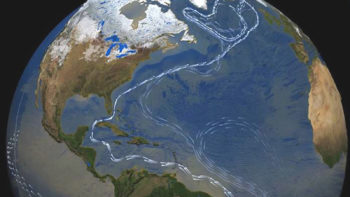Texas A&M Experts Explain Slowing Ocean Currents

For decades, oceanographers have been measuring the Atlantic Meridional Overturning Circulation (AMOC), a large system of ocean currents that greatly influence Earth’s climate. In recent years, the data show it is weakening. But what does this mean?
“If this system of currents significantly slows down, this could change weather patterns in the tropics, with a detrimental effect on crop yields,” said Spencer Jones, a visiting assistant professor in the Department of Oceanography at Texas A&M University.
The AMOC is technically still within its natural normal range for speed, experts say, but as global warming continues, the AMOC could possibly slow dangerously. Some scientists say that we are already seeing the effects of this slowing in recent abnormal weather patterns. One thing most scientists agree on, though, is the importance of the AMOC to the climate.
“Changes to the AMOC strength are likely to change the weather patterns in regions like Central America and Indonesia,” Jones said. “Even though the atmosphere compensates for some of the northward heat transport by the AMOC, the Northern Hemisphere still ends up being a bit warmer than the Southern Hemisphere. Most scientists agree that temperatures in northern Europe (particularly Norway) are warmer because of the additional heat transport of the AMOC.”
Because the AMOC is within its natural range as far as the speed of its currents, some might think there is nothing to worry about. Jones, however, disagrees.
“Whether or not it is true that the AMOC has been slowing down for a long time, most scientists expect that the AMOC will slow down quite a lot over the next few decades,” Jones explained. “That’s because as the climate warms, the Greenland ice sheet will melt, and a lot of freshwater will enter the Labrador, Greenland and Irminger seas. Fresh water is lighter than salty water, so the surface water in these areas will get lighter, and less water will sink into the deep ocean.”
Though we don’t necessarily see all the work the AMOC is doing to keep our climate stable, Jones notes that its currents absorb excess carbon dioxide as well as excess heat.
“About 40 percent of the extra carbon dioxide and 90 percent of the heat humans have added to the Earth system by burning fossil fuels has been dissolved in the surface ocean,” Jones said. “But the surface ocean can only take up a limited amount of carbon dioxide and heat. The AMOC moves these surface waters into the deep ocean, allowing more carbon dioxide and heat to be taken up by the ocean, and reducing atmospheric temperature increases. If the AMOC slows down, less carbon dioxide and heat will be taken up by the deep ocean and more will end up in the atmosphere, causing temperatures to be higher at the Earth’s surface.”
Changes in climate will lead to adverse effects in itself. According to Jones, effects could include drought stress on agricultural production, which could lead to food insecurity on a global scale.
“Because of its importance to the Intertropical Convergence Zone, AMOC slowdown would lead to large changes in precipitation in the tropics, including in Central and South America, India, South East Asia and parts of Africa,” Jones added. “Billions of people are reliant on crops grown in these regions, and changes in precipitation patterns could cause it to become even more difficult for these people to obtain food, leading to mass starvation and mass migration.”
As for why the AMOC is slowing, global warming may be to blame, according to Ramalingam Saravanan, professor and head of the Department of Atmospheric Sciences.
“One of the reasons it may be slowing down is because of global warming, and that can increase the amount of, for example, rainfall in the northern regions of the Atlantic, and that makes the water fresher and lighter,” Saravanan said. “One way to stop that is to stop global warming.”
Fortunately, there are many strategies available to policymakers to prevent the currents from slowing to dangerously low speeds, Jones said, such as stopping the burning of fossil fuels and reducing emissions of carbon dioxide as well as other greenhouse gasses.
“Whatever we do to reduce global warming is going to require us to make changes across a wide range of factors, including how we handle public transport and electrifying the driving infrastructure that we have,” Jones said. “We should consider how to reduce the amount of flying and replace that with electric trains. In the agriculture sector, we could start moving away from eating so much red meat. In particular, eating less beef is one of the easier ways to reduce the amount of emissions because land use causes greenhouse gas emissions. We should start trying to heat and cool our homes without burning gas. We can start using electricity, wind, solar and also just reduce the amount of energy that we use to do that by installing infrastructure like heat pumps.”
Jones said many experts believe that if policymakers around the world make a collective effort to stop global warming, the slowing of the AMOC as well as other major changes in Earth’s environment and climate can be prevented.
“Individual action is important, but it’s more important that everybody agrees to support programs that help us move toward electrification of services and more public transport, because really many people don’t have the option to significantly reduce their carbon footprint without help,” Jones added.
Media contact: Shana Hutchins, shutchins@tamu.edu





